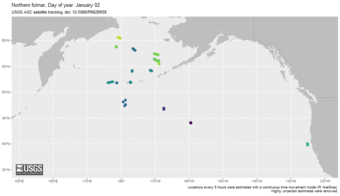A Northern Fulmar on the water offshore of Anchor Point, Cook Inlet
A Northern Fulmar on the water offshore of Anchor Point, Cook InletA Northern Fulmar on the water offshore of Anchor Point, Cook Inlet on July 18, 2018.

An official website of the United States government
Here's how you know
Official websites use .gov
A .gov website belongs to an official government organization in the United States.
Secure .gov websites use HTTPS
A lock () or https:// means you’ve safely connected to the .gov website. Share sensitive information only on official, secure websites.
Available here are tracking data for the northern fulmar, a seabird species that breeds throughout northern ocean regions and spends the winter at-sea in the northern hemisphere. These data were collected to better understand the migratory patterns of northern fulmars in the Bergin Sea.
Return to Ecosystems >> Wildlife Tracking Data Collection
USGS Alaska Science Center scientists collect data from wildlife tracking devices to: determine locations of animals throughout their annual cycles, understand patterns of habitat use, quantify time spent on various behaviors, and identify geographic areas repeatedly used by wildlife that may indicate sites of importance to species and populations. Tracking data from other wildlife species can be found at: https://doi.org/10.5066/P9VYSWEH

Northern Fulmar Tracking Maps
These webpages contain five different types of browse maps and other visualizations of the tracking data.
Argos Satellite Telemetry Data
These data packages contain the data collected from satellite transmitters attached to free-ranging animals. The packages include both raw and processed location and sensor data. The raw data includes data as originally retrieved from the Argos System. The processed data have been filtered for location plausibility, and sensor data have been decoded into standard measurement units. For most users, the processed data will be preferred.
NOTE: Processed data contains both plausible (DAF_Filter=0) and implausible (DAF_Filter=1) locations as indicated by the column “Location_DAF_filter”. Before using these data, we recommend excluding locations flagged as implausible or apply an alternative filtering method of your choice.
Hatch, S.A., Gill, V.A., Mulcahy, D.M., Douglas, D.C., 2020, Tracking data for Northern Fulmars (Fulmarus glacialis) (ver 1.0, October 2020): U.S. Geological Survey data release, https://doi.org/10.5066/P992BR5E
Below are other science products associated with Northern Fulmar.
Below are data or web applications associated with the Northern Fulmar tracking project.
Below are multimedia items associated with Northern Fulmar.

A Northern Fulmar on the water offshore of Anchor Point, Cook Inlet on July 18, 2018.
A Northern Fulmar on the water offshore of Anchor Point, Cook Inlet on July 18, 2018.
Northern Fulmars on the water
Northern Fulmars on the water
Below are publications associated with the Northern Fulmar tracking project.
Available here are tracking data for the northern fulmar, a seabird species that breeds throughout northern ocean regions and spends the winter at-sea in the northern hemisphere. These data were collected to better understand the migratory patterns of northern fulmars in the Bergin Sea.
Return to Ecosystems >> Wildlife Tracking Data Collection
USGS Alaska Science Center scientists collect data from wildlife tracking devices to: determine locations of animals throughout their annual cycles, understand patterns of habitat use, quantify time spent on various behaviors, and identify geographic areas repeatedly used by wildlife that may indicate sites of importance to species and populations. Tracking data from other wildlife species can be found at: https://doi.org/10.5066/P9VYSWEH

Northern Fulmar Tracking Maps
These webpages contain five different types of browse maps and other visualizations of the tracking data.
Argos Satellite Telemetry Data
These data packages contain the data collected from satellite transmitters attached to free-ranging animals. The packages include both raw and processed location and sensor data. The raw data includes data as originally retrieved from the Argos System. The processed data have been filtered for location plausibility, and sensor data have been decoded into standard measurement units. For most users, the processed data will be preferred.
NOTE: Processed data contains both plausible (DAF_Filter=0) and implausible (DAF_Filter=1) locations as indicated by the column “Location_DAF_filter”. Before using these data, we recommend excluding locations flagged as implausible or apply an alternative filtering method of your choice.
Hatch, S.A., Gill, V.A., Mulcahy, D.M., Douglas, D.C., 2020, Tracking data for Northern Fulmars (Fulmarus glacialis) (ver 1.0, October 2020): U.S. Geological Survey data release, https://doi.org/10.5066/P992BR5E
Below are other science products associated with Northern Fulmar.
Below are data or web applications associated with the Northern Fulmar tracking project.
Below are multimedia items associated with Northern Fulmar.

A Northern Fulmar on the water offshore of Anchor Point, Cook Inlet on July 18, 2018.
A Northern Fulmar on the water offshore of Anchor Point, Cook Inlet on July 18, 2018.
Northern Fulmars on the water
Northern Fulmars on the water
Below are publications associated with the Northern Fulmar tracking project.
